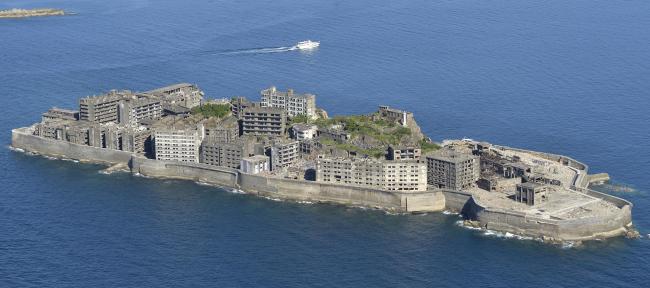Japan said Monday it has secured a UNESCO advisory panel’s endorsement for the listing of major wartime industrial facilities as World Heritage sites, posing a threat to Seoul’s efforts to keep the move at bay amid unabated historical spats.
The International Council on Monuments and Sites, or ICOMOS, has recommended the registration of 23 sites of “Japan’s Meiji Industrial Revolution,” built in the late 19th to early 20th centuries. They were credited with contributing to Japan’s rapid industrialization and adaption of western technologies to its needs, according to Tokyo’s Cultural Affairs Agency.
Yet Tokyo’s campaign triggered stiff opposition from Seoul as it includes seven facilities where hundreds of thousands of Koreans were forced into slave labor under Japanese colonial rule.
 |
Hashima undersea coal mine off Nagasaki, known as “Battleship Island,” one of the 23 sites of “Japan’s Meiji Industrial Revolution” Japan is pushing to have registered as World Heritage sites. (Yonhap) |
Among them are the Hashima undersea coal mine off Nagasaki, known as “Battleship Island.” The workers, mostly conscripted from Korea and China, had to work more than 12 hours a day, isolated from the outside world and facing frequent tunnel collapses, gas explosions, falling rocks and other harsh work conditions.
Koreans were also mobilized to build warships, torpedoes and other military supplies in the Nagasaki shipyard run by Mitsubishi Heavy Industries. Many of them died, either in the U.S.’ atomic bombing in 1945 or while carrying out reconstruction work afterward.
A formal decision is forecast to be made at a World Heritage Committee meeting in July in Bonn, Germany.
With both countries being among the 21 members, they are expected to ramp up diplomatic efforts ― Japan to clinch the listing and Korea to fend it off.
Yet Seoul will likely struggle to turn the mood around, given that few sites recommended by ICOMOS have so far been rejected in the final stages.
Tokyo also opted to package the 23 sites spanning some 1,300 kilometers across eight prefectures in the form of a “serial nomination,” which could facilitate UNESCO’s assessment while watering down controversies concerning its wartime atrocities.
“Despite our efforts to carry our position, ICOMOS appears to have made the recommendation only from the technical aspect in line with its customs,” Seoul’s Foreign Ministry said in a statement.
“We’re making our utmost efforts to have our sensible concerns taken into account that it runs counter to the fundamental spirit of the World Heritage Convention to beautify the facilities as purely industrial ones and include them as World Heritage sites without acknowledging that forced labor took place there.”
A successful entry of the seven facilities is expected to deepen the quandary of Foreign Minister Yun Byung-se, who has recently come under fire for what critics call complacent responses to pressing diplomatic issues such as Japan’s accelerating revisionist push backed by Washington, a possible stationing of advanced U.S. missile assets on the peninsula, and Seoul’s belated joining of a China-led development bank project and a U.S.-led transcontinental trade pact.
Some lawmakers called for his resignation at a parliamentary session on Monday. Yun responded he did not insist on maintaining the top diplomat job, but defended his actions.
“Some may view that there is a problem with our foreign policy but basically the international community is criticizing Japan’s revisionist drive,” he said.
“But as the Japanese government would not easily make concessions and given the nature of the matter, it is appropriate to work with the U.S., Germany, the European Union and other countries.”
By Shin Hyon-hee (
heeshin@heraldcorp.com)








